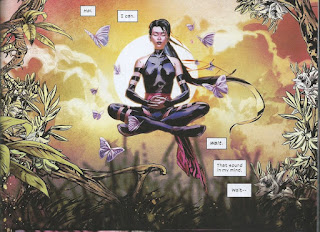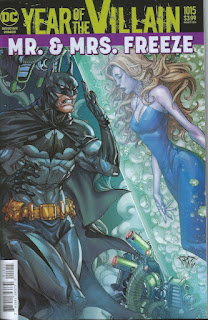Pick of the Brown Bag
November 13, 2019
by
Ray Tate
Welcome to the Pick of the Brown Bag, a weekly comic book review blog. This edition’s contenders include the Black Cat Annual, Black Hammer and the Justice League, Detective Comics, Fallen Angels, Far Sector, Unbeatable Squirrel Girl and Vampirella and Red Sonja. The Tweets are already live and can be reached: #PickoftheBrownBag. For those that have more time on their hands enjoy the richer reviews…starting….now.
The story began when in the 1960s. Still fresh from her arrival to earth a year ago, Vampirella decided to investigate a real life mystery. Approximately nine hikers were found dead on the Dylatov Pass.
V hightails it to the Soviet Union. She quickly souses out locals for UFO sightings and takes the guise of a reporter who asks perturbing questions to the science minister.
V takes the initiative, flies to the the Dylatov Pass and discovers not little green men, but a Red-Haired She-Devil. Involving a pen-pal, V resolves communication issues and allies with Sonja.
Writer Jordie Bellaire makes his presence known with repartee and a smart revelation that ties in Drakulon and the then advanced Russian space program. He provides a paranormal explanation for the Dylatov Pass Incident, but it fills in the blanks quite nicely. At the same time, Bellaire reinforces the bond between Red Sonja and Vampirella, and in the end Sonja makes an important vow that establishes their sisterhood.
The conclusion of Vampirella and Red Sonja is mostly action-oriented, and because of that, Drew Moss becomes the most important component in achieving satisfaction. Moss isn’t just a one-trick pony however. I commented on his rendering of emotion and comic timing. That skill set imparts character to the action.
As well Moss uses a technique that’s fallen out of favor. Speed lines.
Vampirella is an alien superwoman who doesn't worry about niceties, and Moss demonstrates what happens when somebody with that kind of power is against you.
Vampirella is an alien superwoman who doesn't worry about niceties, and Moss demonstrates what happens when somebody with that kind of power is against you.
The Black Cat and Spider-Man used to be an item. Alas. T’wasn’t meant to be. Indeed, for a while, Spidey believed Black Cat dead. The Black Cat however returned to help and vex Spider-Man.
That history is up for interpretation thanks to Black Cat series writer Jed MacKay. MacKay may not have the cache to eliminate all the rotten things done to the Black Cat in the past, but he’s doing his best to ignore them. So, Spider-Man and Black Cat, amicable exes. No psychological baggage. Light hearted banter instead.
I love the Black Cat, and the Annual is just filled with more hi-jinks from the Spidey, Felicia and her crew Bruno and Dr. Korpse.
I’m not going to is explain the why of the wedding. That is some extra whacky dipped in Marvel lore and chocolate coated with wtf. I will instead say that the wedding leads the Black Cat and Spider-Man into a death trap that may or may not lead to a big pay off.
Somebody remembered that Spidey carries his own Spider-Signal. This just may be one of the best Spider-Man books as well as Black Cat books ever produced.
In addition to the Spider-Signal, MacKay uses Spidey’s Spider-Sense to its fullest. He addresses Spidey and Felicia’s chemistry. A giant robot crashes the party. Bruno and Dr. Korpse make vital contributions to the grand theft. MacKay importantly clears Spider-Man of wrong-doing.
The whole exercise is lovely. In writing and artwork. Joey Vasquez, Natacha Bustos, Juan Gedeon and colorist Brian Reber all strike the right tone with comical takes from Spidey and sly cuteness from Felicia.
It’s the end of Unbeatable Squirrel Girl.
Wooo. Talk about scorched earth. Seriously though, that’s not how Ryan North concludes the adventures of a character he shaped more than any other writer. Instead, for this last issue, North alludes to all the things that made this book and his Squirrel Girl special.
She has the powers of a squirrel and the powers of the girl. Squirrel Girl is feminist by example. North demonstrated Squirrel Girl’s intellect as much as her abilities throughout the series, often giving lessons to the reader. I loved the idea that every book in the Library of Babel can be dissected into binary.
She has the powers of a squirrel and the powers of the girl. Squirrel Girl is feminist by example. North demonstrated Squirrel Girl’s intellect as much as her abilities throughout the series, often giving lessons to the reader. I loved the idea that every book in the Library of Babel can be dissected into binary.
Squirrel Girl also saw it her duty to redeem as many villains as she could. Norse chaos squirrel god, Ratatoskr, her most recent triumph. Kraven one of her earliest attempts.
When I heard that Marvel turned Kraven into a family, I supposed that the Kraven in Squirrel Girl was one of the less evil of the fellows. He wasn’t the one behind Kraven’s Last Hunt or Tigra’s unsavory enslavement from a classic Marvel Team-Up. Same guy though.
North could have brushed this under the rug, but he actually thought things through. He presented the Trial of Kraven. Doreen attempted to broker a peace between Kraven and Spider-Man, a hero he tried to literally bury alive.
It’s ultimately Doreen’s friends and her ability to make them, with her intelligence, pluck and openness that saves her from an arch foe, her first foe, Victor Von Doom and her most recent villain Melissa Morbeck.
North exhibits an ability to rewrite dramatic Marvel characters in a funny way that nevertheless grants them the dignity of their resonance. So, Doom is a riot in Squirrel Girl, and he also rings true. He’s not telling jokes. His manner is the trigger for comedy.
Likewise for the artists Erica Henderson and Derek Charm. In uniquely cartoony styles they brought together the Marvel Universe—including Tigra—in Squirrel GIrl honestly and without ridicule. This was a great comic book series.
Fallen Angels is a Psylocke book, and if you’re nuts about Psylocke this is the comic for you. If you think Psylocke is Betsy Braddock, Captain Britain’s sister, stay away. If you’re buying the book for X-23, prepare for disappointment. Cable fans? I suppose there must be a few of them out there. Marginal purchase at best.
I took a chance on Fallen Angels for X-23, but I like Psylocke well enough. Of course, she was Betsy Braddock then. She’s somebody else now.
When did Psylocke stop being Betsy Braddock, and who is Kwannon? Psylocke debuted in Captain Britain illustrated by a neophyte named Alan Davis. She was a cast member.
So now she’s Kwannon and Betsy is somebody else. I guess in a clone body. Were they sharing an existence? I give up. Let’s chalk this up to whatever.
Bryan Hill’s story builds on Kwannon’s history. It’s similar to a host of Hong Kong films from the nineties based on Luc Besson’s Nikita. Kwannon was a Samurai who had a child. Things went bad after that.
These weird schools for assassins do this kind of thing all the time. Especially to female assassins. The kid’s all grown up now and screwed by Apoth, the organization that gave her the fancy headgear.
The premise of Hill’s story is that Apoth is evolving mankind outside of mutant evolution, but you cannot evolve without mutation. Mutation is the engine of evolution, creating genetic variation. Any technical evolution is artificial. These facts niggled me throughout my reading of Fallen Angels. The Kwannon stuff irritated me. The lack of X-23 involvement bored me, and the weird look of the book filled with close ups of lips and eyes concluded my involvement.
There are about thirteen pages of this Sergio Leone hackery and why the hell is Magneto sitting in the dark? Sinister I get. He’s manipulating holograms. The light could interfere, but Magneto’s got no excuse.
After reading two X-Men books two weeks in a row, Far Sector is a tonic. Far Sector by N.K. Jemisin and Jamal Campbell who also spreads the extraordinary colors throughout the panels is literate science fiction starring a new Green Lantern. The first issue briskly introduces the problem.
The narrative and dialogue almost makes a reviewer unnecessary to explain. In summary this is a murder in a Utopian society.
The society is a conglomerate of war survivors that built a Dyson Sphere around The City Enduring. The society eliminated future conflict between their species by eliminating emotion.
The aliens for lack of a better word reflect social media influence. This kind of up to date writing often sours on me. The author and the illustrator however also bank on science fiction traditions.
The City of the Enduring is straight out of the pulps with gleaming architecture that bears engineering factuality. Green Lantern Sojourner Mullein with her pompadour hair and futuristic glasses looks to have stepped out of Amazing Stories.
We have multiple species with remarkable fashion senses that are nothing too outlandish. In short, this is science fiction with a broad appeal. It invites you to experience the wonders of Enduring and sink your teeth in a promising mystery by following and competing against an engaging detective.
Detective Comics continues the fascinating evolution of Nora Fries. Adam West’s television series introduced the world to Mr. Freeze, a criminal mastermind who only can live in a cold environment. Batman the Animated Series took that idea and reinvented it for modern audiences. They introduced a love interest for Victor Fries named Nora “surrounded by winter, forever young.”
Freeze intended to do anything to save his wife. These aims often led him to conflict with Batman. Years later, Peter Tomasi orchestrated Victor’s success.
However, Nora’s freedom comes at a cost, and Victor doesn’t like it. So, he proposes a bargain with Batman.
Before what some would identify as inevitable, Batman works with Alfred and Lucius Fox to reverse the fate of Victor’s test subjects and his and Nora’s victims.
The moment by Doug Mahnke and Jose Luis an army of inkers and colorist Dave Baron visually depicts the history of Alfred and Batman in one subtle and comical look.
Alfred knows that arguing with his Master Bruce over matters of life and death is a fruitless endeavor. Time for the innocent is of the essence.
Black Hammer and the Justice League ends in a satisfying wallop of heroism. Something trapped the heroes from another universe in a rural Möbius Strip. They could not escape The Farm, until a Big Bad from the Justice League’s past found a loophole. He swapped the League for the Black Hammer heroes.
Much chaos ensued, and it took the combined efforts of John Stewart and Black Hammer’s Colonel Weird along with the presumed dead Flash to find a way out.
The League’s elation, even love from Batman, over the Flash’s return alludes to Justice League the Animated Series. In an alternate universe, the Flash’s death incites the downfall of the League. They become authoritarian Justice Lords, taking over the earth and ruling it.
The Big Bad admits defeat and promises to undo the deed if the Black Hammer group strike a deal.
The unfamiliarity of Black Hammer works in the book’s favor. You know that the League wouldn’t hesitate to return to the Farm to save the world, but you’re unsure about the strangers in the mix.






























No comments:
Post a Comment